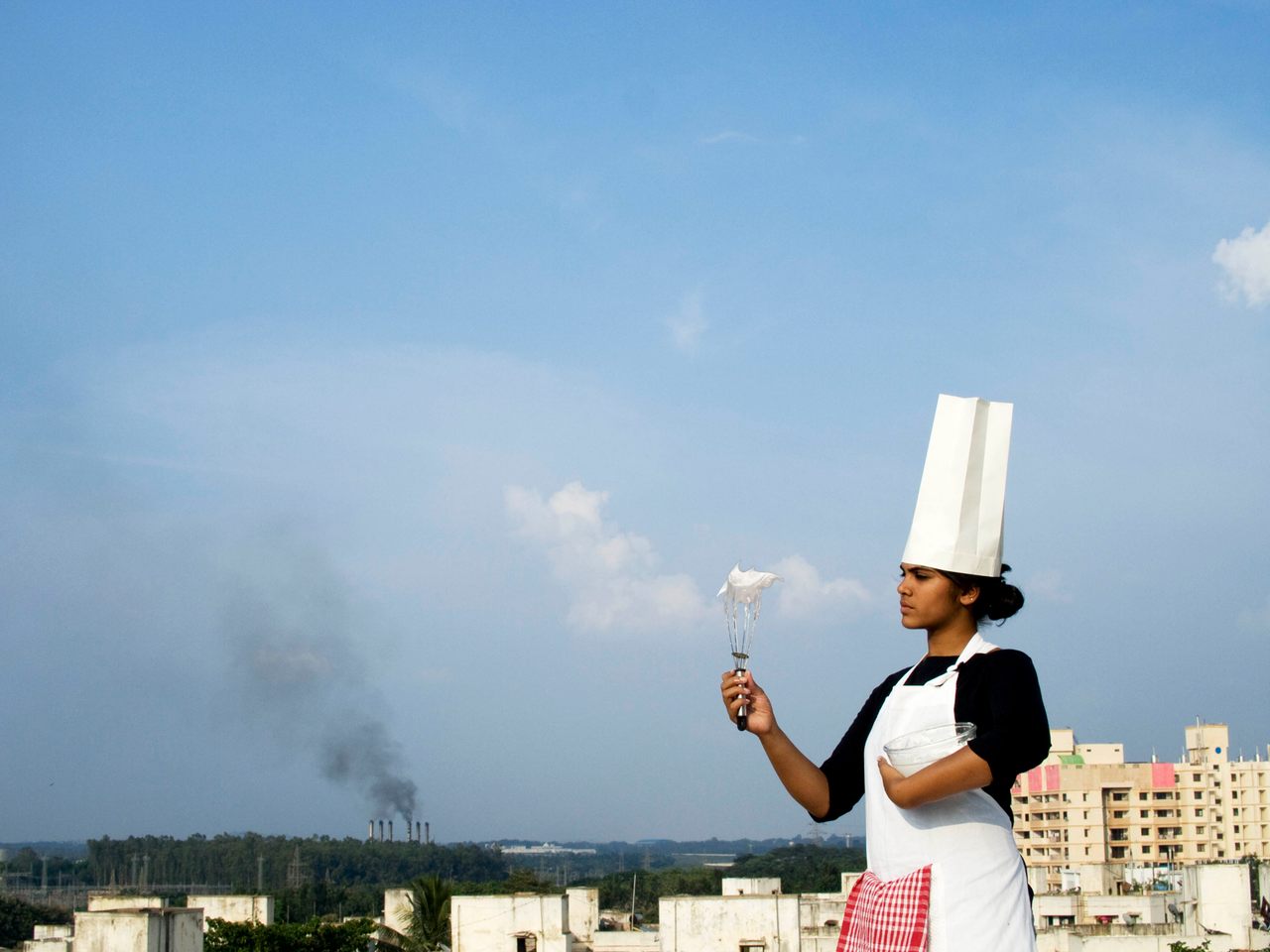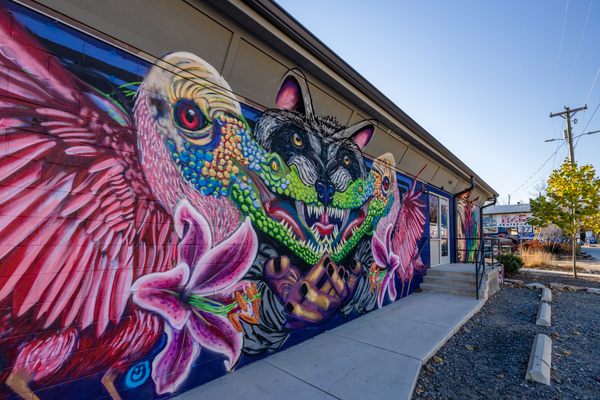
With Smog Meringues, You Can Taste Your City’s Air Pollution
Artists whip up a way for your taste buds to go through what your lungs do every day.
Tasting notes for wine often reference other delicious things. In a chardonnay, you might hope for hints of vanilla, butter, and caramel. Merlot is said to call to mind black cherry, plums, and chocolate. You wouldn’t think it, but cities have tasting notes, too. Each has a unique smog bouquet. If the smog is from Los Angeles—authorities call it Angelina smog—you’ll sense bleach and other cleaning products. London smog has a mouthfeel redolent of dirt. Atlanta smog has oleaginous notes of alcohol. And Beijing? “A lot more sulfurous,” says writer and journalist Nicola Twilley. “It has that kind of fart smell going on.” In a blind taste test, she says, you’d be able to tell the difference between them, but you might struggle to identify each one’s source, “unless you were a connoisseur of smog.”
If the flavor profile of air pollution isn’t something you’ve given much thought to, you’re not alone. But an artist-led think tank, the Center for Genomic Gastronomy, wants to change that, or at least invite more thought about what we put into our bodies with each breath we take. So they’re taking distinctive smog profiles from around the world, whipping them into meringues, and asking people to have a taste. These “Trojan treats,” as their creators describe them, have gone from Geneva to New Delhi to New York to Barcelona, from the United Nations Climate Change Conference to the meetings of the World Health Organization (WHO). Each crisp, eggy cookie contains chemicals—and a necessary conversation.
It all started in Bangalore, India, a city with air that contains more than six times the WHO’s safe guidelines for particulate matter. Artist Zack Denfield, one of the Center’s founders, was teaching at the city’s Srishti Institute of Art, Design & Technology in 2011. In his spare time, he was working his way through Harold McGee’s enormous tome, On Food and Cooking. In a paragraph about meringues—baked cookies or dessert topping made by stiffly beating eggs with sugar—a “tiny turn of phrase” caught his attention, he says. “Thanks to egg whites,” writes McGee, “we’re able to harvest the air, and make it an integral part of meringues and mousses, gin fizzes and soufflés and sabayons.”


Denfield had never come across the idea of “harvesting the air” before. It’s a curious expression, which appears most frequently in discussions of 12th-century windmills. But seeing those two “unusual words bumping up against each other,” in an aggressively polluted city, set off a chain of thoughts in his head. Shortly afterwards, in what must have been a surreal sight for the swarming workers of tech-hub Bangalore, his students stood at intersections and smog hotspots around the city, armed with whisks, whipping that smog into egg whites.
In an abstract way, at least, people have worried about smog for well over a century. The word is usually credited to an H.A. des Voeux, of the Coal Abatement Society. His 1905 paper, Fog and Smoke, posited that one needs no science to see that there is something great cities alone produce—smoky fog, shortened to the portmanteau “smog.” In 1926, the word was officially picked up by the United States Weather Bureau. The New York Times erroneously reported that the bureau had “given a new word to the American language,” and defined the phenomenon as when “smoke and fog unite at the same density, the smoke particles crystallizing in the chill air and being carried along in a fog blanket.” Indiana, they wrote, was already waging war on it.
Twelve years later, in 1938, Pittsburgh’s smog was cited as the reason for its unusually high pneumonia death rate. In 1948, 20 people died in Pennsylvania when a blanket of toxic yellow smog, belched out by the local zinc plant, covered the town of Donora. In 1963, the United States passed the Clean Air Act. Air condition remains a serious—even worsening—problem, especially in the developing world. “Fifty-plus years of scientists and environmental activists using rational arguments haven’t really made us change our behavior,” Denfield says. Now, he thinks, it may be time to leave behind rational appeals in favor of ones that are emotional, or “arational.” He has wondered whether this is a problem of tangibility—you can’t touch smog, or hold it in your hand. (That said, humans seem similarly unbothered by other, more visible kinds of pollution—like clogged waterways or trash islands.) But when you do, he offers, through something like these smog meringues, it might engage a different way of relating to the problem. “The simple transformation of the air that you actually breathe into another product or service,” says Denfield. “Nothing’s really changed, but it changes a lot in people’s minds.”

In Bangalore, Denfield’s students were changing smog from lungfuls into mouthfuls. The recipe for smog meringues is simple: three egg whites per site, whipped with three-quarters cup of sugar, then baked for 90 minutes at 300 degrees Fahrenheit. “It was a great concept, but hard to then compare the taste of air from different places around the city,” says Twilley, who became involved with the project later on. “The entire point is that you’re whipping air in from a particular traffic intersection, and you can’t wait and go back to the kitchen and bake it, because you’ll lose your particular air.”
What they needed was a way to compare smogs—each with its own chemistry, pH, and flavor—side-by-side, in a kind of taste-test. “That’s where we ended up coining the term ‘aeroir’ to talk about what you were tasting,” says Twilley. The terms is a play on “terroir,” or the suite of factors, from soil to sun, that imparts flavor to wine grapes and other crops.
One could, technically, harvest smog at its source, but a more reliable alternative was to manufacture those “varietals” in a lab. Environmental scientists have already developed “smog recipes,” which characterize a city’s distinctive combination of pollutants into a characteristic essence. By following these formulas, the artists would have a ready guide to the many regional smog cuisines. So, when Twilley received some funding from the Finnish Cultural Institute of New York in 2015, she and the Center began work on a makeshift smog synthesizer, similar to those used in labs.

But not exactly the same. The components were unorthodox—bicycle pumps and long black vinyl gloves, “which we had to buy from a sex shop because those were the only ones we could find that were long enough.” Sourcing the chemicals they needed was also a challenge. Scientists can order toxic chemicals with relative ease, but the artists had to find workarounds, like home chefs trying to replicate the contents of a snack food aisle, with the help of scientists from the University of California, Riverside. Reddish-brown nitrogen dioxide can be produced by dropping a penny in nitrous acid. “Hydrocarbons—those evaporate off if you just leave diesel in a glass dish,” says Twilley. For sulfur, they struck match after match, and then pumped the resulting gas into the synthesizer. Soot came from candles—“light a candle, blow it out, pump that in, light a candle, blow it out, pump that in.” Particulates were harvested from Twilley’s own roof, by the heavily trafficked Brooklyn-Queens Expressway, and added to the mix. Sometimes, the characteristics of a smog come from how it is cooked. Angelina smog, for example, bakes under the Southern California sun, so the team bought an ultraviolet light. Finally, once every ingredient was made and contained in its own chamber, they attached bicycle pumps to move the gas into a main smog-mixing chamber. “You could see as each of the different chemicals got pumped in,” Twilley says, “the chamber would start to fill with brownish or yellowish air.”

A member of the collective then places her arms into the chamber, through the black vinyl gloves, to whip the egg whites within to stiff peaks. It is then removed, dropped onto cookie sheets, and baked. “This is not, as it turns out, the way to make a good meringue,” says Twilley, laughing. “Some of the chemicals obviously affected the meringue’s ability to hold a shape, some of the meringues were really open and bubbly in a way that they shouldn’t be.” Some were yellow, others brown or gray. “The meringues were not ones that you’d pay good money for at Ottolenghi. But they did capture some of the qualities of the smog that they were whipped up in.” In the end, they mostly carry the blandish sweetness of white sugar, with the aftertaste of whatever nasties that smog included—such as the pine notes of terpenes, or the grit of particulates.

The smog meringues made their debut to the general public at a meeting of the WHO—but Twilley fondly recalls the New Museum’s Ideas City festival in May 2015. Rather than being exhibited with the other artists, they were sandwiched between artisanal lobster rolls and high-end donuts—in the luxury food court. Unlike the other “treats,” their offerings were free. “We were mobbed,” she says. People came back time and time again, until they had completely run out of meringues. Many were concerned about whether it was safe to ingest them. “Well, is it safe to breathe?” says Twilley. “No, but it’s about dose.”
And are they safe to eat? Most of the chemicals are not things you’d be advised to ingest intentionally or in quantity. But, perhaps ironically, there’s evidence, though scant, that “eating” smog is not as bad for you as breathing it. One scientist Twilley spoke to thought that human digestive systems—honed by evolutionary history—are likely better equipped to handle toxins than lungs are. “We have a robust digestive system that can break things down,” she says. “Whereas our breathing—yes, you have filters against some of the larger particles, but otherwise we’re not set up to filter out poisonous gases as a general rule.”

Critics accused the makers of the smog meringues of making light of a serious problem. Instead, Twilley and Denfield say, they are only trying to sweeten a bitter pill. “Our point was not to be like, ‘air pollution is so fun,’” Twilley says. But by introducing an interactive element—the language of wine tasting, say—the Center hopes to make people think more carefully about what we put into our bodies every time we breathe, which is not a conscious decision. “People are like, ‘Oh, I have a choice whether or not to put that in my body,’ because it’s food,” says Denfield. “Maybe now I want to have a choice about what goes in my body from the air, as well.”
Smog is not going away. Just this week, toxic smog engulfed New Delhi, and particulate levels grew to over 10 times the accepted limit—the equivalent of smoking 44 cigarettes a day. Lahore has seen flights grounded, traffic gridlocked, and schools closed, with students barely able to see beyond the end of their own arms. In the meantime, “smog deniers” are blowing onto the world stage. In 2012, scientist Robert Phalen, recently appointed by President Trump to the Environmental Protection Agency’s Scientific Advisory Board, told the American Association for the Advancement of Science that children benefit from dirty air. Their “lungs need a few irritants to learn how to ward them off.” Indeed, he said, “Modern air is a little too clean for optimum health.” And in India, politician Prakash Javadevar has been dismissive, even Nero-like, about the country’s growing pollution problem. When a WHO report last year listed more than 30 Indian cities among the world’s 100 most polluted, he said simply that it was “misleading.”

But we know just how bad smog is, says George Thurston, who wrote the WHO’s Global Burden of Disease air pollution report. Speaking to Greenpeace’s Unearthed, he said: “The relationship between ambient air pollution exposure and human mortality is even more definitively quantified, with a broad scientific consensus, than the relationship between human activity and climate change, likely because death is a more definitively defined endpoint than climate change.”
Now, six years after Denfield’s original brainstorm, smog meringues keep on going. The Center recently applied for funding for a YouTube cooking series, and Denfield continues to take the smoky treats on tour around the world. “We keep doing this because we can see that, for audiences who are experiencing it for the first time, it does something different to their minds and to their bodies,” he says. The key, Twilley says, is in trying to make near-invisible atmospheric problems visible by changing the mode of interactions. “Rather than breathing, it’s eating. And by changing the mode of interactions, you just force a pause and a thought and a conversation.”
Gastro Obscura covers the world’s most wondrous food and drink.
Sign up for our regular newsletter.








































Follow us on Twitter to get the latest on the world's hidden wonders.
Like us on Facebook to get the latest on the world's hidden wonders.
Follow us on Twitter Like us on Facebook